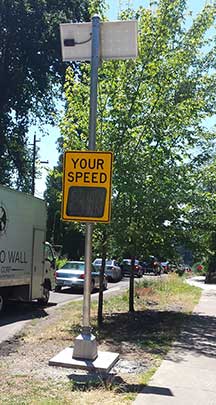 |
Previous Issues |
| Cedar Mill Community Website |
|
Search the Cedar Mill News: |
About The Cedar Mill News |
|
|||||||
| Volume 15, Issue 8 | August 2017 |
||||||
Road safety becoming top priority
|
|||
 |
“To my lovely neighbors of Lost Park Drive, too many cars blew past my sons and I as we waited for their summer school bus, imagine your kids are at the stop, would you drive beyond 25?” wrote Kimie Knox on NextDoor. Her comment elicited others, including my own (full disclosure -- I live and walk my dogs in the area).
Several Lost Park area residents added to the discussion about what can be done to slow traffic on the street, much of which has no sidewalks. One NextDoor member, Laurel Manville, suggested contacting the Neighborhood Streets Program (NSP), run by Washington County. So, I checked into it.
First the bad news, though. Lost Park Drive is fairly quiet, compared to other county roads, says NSP program coordinator Michael Mills. Just under 700 cars per day use it, a number that is “very low and remaining about the same.” Speed display sensors also show drivers are mostly under the posted 25 mph limit.
Streets that qualify for the permanent sensors—like NW 113th has now—need bigger numbers, from 1,500 to 2,000 cars per day. And 85 of 100 drivers have to exceed the posted speed limit by six or more mph. Downhill 113th drivers do that regularly, clocking 41 mph on average. If you’re wondering why the speed display sign is mid-hill and not at the bottom, that had to do with where the concrete footing would fit into the ground. Off Valros Lane was the best spot.
The good news is that residents who want to take action to slow down drivers do have recourse through the NSP. It’s not a quick fix, but there’s a range of options. Neighbors can ask for lawn signs imploring drivers to slow down, as one has done on upper Lost Park Drive. Mills can send out one of his trailers to clock speeds, as he has done. Motivated neighbors can even sit out with a radar unit and write down the license plates of speeders who get “a courtesy letter” from the county asking them to slow down. That last doesn’t get many takers, he says. To see the complete list, visit the website.
But what about speed humps (those with the slots for emergency vehicles) or speed bumps? That’s tougher to come by. The county is in the business of moving traffic and there must be a compelling need to install them. Streets that are too steep, like NW 113th, don’t qualify. Get going too fast, hit a bump and you could get launched into the air. “A landscaper lost his lawn mower when he hit a bump at 35,” says Mills.
Rather than use the brute force of speed bumps to slow drivers, the official attitude, as evidenced by the NSP and Oregon Department of Transportation’s “every intersection is a crosswalk” campaign, is to appeal to the driver, who at another time be could be a walker or bicyclist or a parent waiting for a school bus.
![]()
Like us on Facebook for timely updates
Published monthly by Pioneer Marketing & Design
Publisher/Editor:Virginia Bruce
info@cedarmillnews.com
PO Box 91061
Portland, Oregon 97291
© 2017